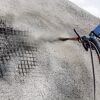Remmers concrete replacement systems for structural stability-relevant repairs show their versatility in applications that range from full-surface use on civil engineering construction works through to the re-profiling of extremely exposed building components in areas treated with de-icing agents. One special property is the high resistance when used with water containing sulphates.
Manual processing
Small damaged areas on concrete structures are generally repaired in a manual process. The concrete replacement system includes a bonding course to ensure adhesion of the coarse mortar on the prepared surface.

Passivation of steel reinforcement in a spray application
Decades of corrosive substances impacting on the embedded reinforcements not only create individual areas of damage on the surface of the concrete but often create widespread harmful effects to the edge of the concrete, in some cases well behind the first reinforcement layer. Usually, extensive repair work is required to repair these building components efficiently. The best method for this is a wet or dry spray procedure.
With the wet spray method the ready-mix material is transported mechanically in a dense stream to the injection nozzle, where it is torn apart by the compressed air and distributed evenly on the substrate. Due to the pumping procedure, only a limited hose length (usually 40 m) can be used. Compared to the dry spray procedure, the wet spray procedure creates less dust and recoil.
With the dry spray method, the powder-like material is pumped pneumatically in a thin stream to the spray nozzle where it is mixed with water into a processable mortar. High pumping lengths and heights can be achieved due to the pumping method. Benefits compared to wet spraying are the reduced cleaning of the machine technology, high pumping lengths and high pumping heights.
Grouting mortar
The 3rd version of the DAfStb guide line ‘Protection and repair of concrete’ regulates the re-profiling of concrete structures with grouting mortars.
The grouting mortar must be reinforced to secure the bond and must be connected to the old concrete via a composite anchor. Verification of the bond and possibly the force must be provided. When re-profiling building components subject to compression, strapping reinforcement must be used. Remmers Betofix HQ6 stands out due to its outstanding flow properties, even in areas where the reinforcements lie close to each other.
Structural concrete repair
13 products foundView:
Article No. 108425
Fibre-reinforced PCC/SPCC (RM/SRM) for the static repair of concrete structures
Article No. 109625
Fibre-reinforced PCC (RM) for static repair of concrete structures
Article No. 108625
PCC I (RM) Concrete replacement mortar for repairing concrete structures/screed mortar












![Betofix R4 EM [basic] Betofix R4 EM [basic]](https://m.remmers.com/gebindeabbildungen/2400w/38637.png?version=0&w=100)